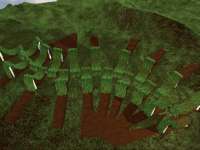ZIPPER CHAIRS
With Zipper Chairs , I am playing with the interaction of natural design and human logic. The structures we live in, whether natural, invented, physical or cultural, all affect our behavior. The idea for Zipper Chairs came from my fascina
Tricia McLaughlin patrimcl@gmail.com Project Description ZIPPER CHAIRS With Zipper Chairs , I am playing with the interaction of natural design and human logic. The structures we live in, whether natural, invented, physical or cultural, all affect our behavior. The idea for Zipper Chairs came from my fascination with the logical approach we use to impose our designs on nature, and how those designs dictate our behavior within it. The chairs are interlocking teeth in a closed zipper that reinforces social interaction. The zipper design is influenced by the Nazca Lines in Peru, origami and suburban developments such as Palm City, Florida. Cutting out the grass from the land to make chairs is in keeping with my ideas of using large-scale Earth drawings like the Nazca Lines as blueprints for architecture. But I use the negative shape left from building the structure to create the aerial drawing. The grass cut-outs used for the chairs make a pattern in the land reminiscent of hands. As chairs, people sit closely bound within these hands. Form is created from functional design. Origami can turn a simple plane into a sophisticated structure. Like paper, the earth can be cut and folded to make chairs for our comfort. These simple shapes create an intricate map for social behavior. The aerial view of Palm City’s suburbia suggest an interlocking organic machine. Since this arrangement of houses is occupied by people, this machine truly is organic. Similarly, this zipper design is a collection of chairs that hold people in its hands. Design and Installation: PVC frames will be the structure for the chairs. The mass-produced white PVC pipe is the perfect synthetic material to suggest man-made bones. From these pipes/bones will hang brown canvas to make the chairs’ backing. Artificial grass or real grass pieces cut from the ground below each chair are laid over the canvas to give the effect of folded earth. The dimensions vary so it can be adapted to different locations. A configuration of 20 chairs would take up roughly 30’ x 40’ (1200 sq. ft.)
Tricia McLaughlin patrimcl@gmail.com aerial view of Palm City, FL aerial view of Zipper Chairs Tricia McLaughlin patrimcl@gmail.com Tricia McLaughlin patrimcl@gmail.com Tricia McLaughlin patrimcl@gmail.com
ZIPPER CHAIRS
With Zipper Chairs , I am playing with the interaction of natural design and human logic. The structures we live in, whether natural, invented, physical or cultural, all affect our behavior. The idea for Zipper Chairs came from my fascina
Tricia McLaughlin patrimcl@gmail.com Project Description ZIPPER CHAIRS With Zipper Chairs , I am playing with the interaction of natural design and human logic. The structures we live in, whether natural, invented, physical or cultural, all affect our behavior. The idea for Zipper Chairs came from my fascination with the logical approach we use to impose our designs on nature, and how those designs dictate our behavior within it. The chairs are interlocking teeth in a closed zipper that reinforces social interaction. The zipper design is influenced by the Nazca Lines in Peru, origami and suburban developments such as Palm City, Florida. Cutting out the grass from the land to make chairs is in keeping with my ideas of using large-scale Earth drawings like the Nazca Lines as blueprints for architecture. But I use the negative shape left from building the structure to create the aerial drawing. The grass cut-outs used for the chairs make a pattern in the land reminiscent of hands. As chairs, people sit closely bound within these hands. Form is created from functional design. Origami can turn a simple plane into a sophisticated structure. Like paper, the earth can be cut and folded to make chairs for our comfort. These simple shapes create an intricate map for social behavior. The aerial view of Palm City’s suburbia suggest an interlocking organic machine. Since this arrangement of houses is occupied by people, this machine truly is organic. Similarly, this zipper design is a collection of chairs that hold people in its hands. Design and Installation: PVC frames will be the structure for the chairs. The mass-produced white PVC pipe is the perfect synthetic material to suggest man-made bones. From these pipes/bones will hang brown canvas to make the chairs’ backing. Artificial grass or real grass pieces cut from the ground below each chair are laid over the canvas to give the effect of folded earth. The dimensions vary so it can be adapted to different locations. A configuration of 20 chairs would take up roughly 30’ x 40’ (1200 sq. ft.)
Tricia McLaughlin patrimcl@gmail.com aerial view of Palm City, FL aerial view of Zipper Chairs Tricia McLaughlin patrimcl@gmail.com Tricia McLaughlin patrimcl@gmail.com Tricia McLaughlin patrimcl@gmail.com

